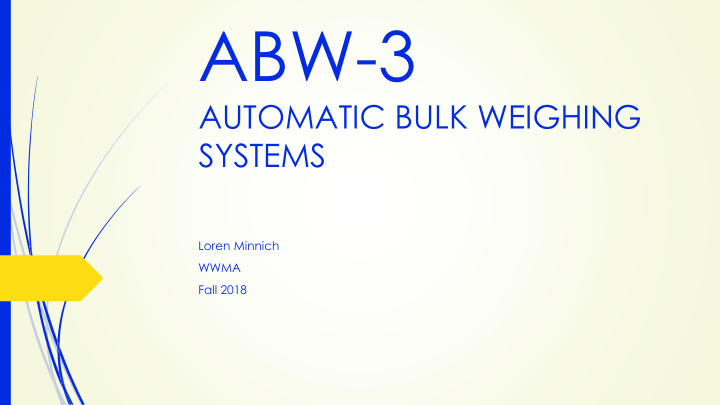



ABW-3 AUTOMATIC BULK WEIGHING SYSTEMS Loren Minnich WWMA Fall 2018
Purpose: To modernize the current ABWS code to include technology in use or available, while maintaining current safeguards in the code.
WHY? Some NTEP approved ABWS systems do not meet current specifications This was not an error on NTEP’s part, rather it was an effort to accommodate newer designs. Automatic bulk weighing systems are becoming more common More efficient than traditional hopper scale systems Potentially more accurate than a hopper scale system or AWS because of the use of “no load reference” weights. Current codes can make it difficult to distinguish between a hopper scale system, an ABWS, or an AWS.
ABWS History NCWM Interim January of 1982 Representatives of the Federal Grain Inspection Service (FGIS) express a desire for cooperation with the conference in developing uniform standards for the devices that fell within the jurisdiction of both FGIS and local and state weights & measures officials. They mentioned two specifically: Automatic Electronic Bulk Weighing Systems (Grain) Grain Test scales NCWM Interim January of 1983 S & T committee reviews a draft code for “Automatic Grain Bulk Weighing Systems” They “decided that it (the draft code) had considerable merit, and that it could be applicable to not only grain but all automatic bulk weighing systems .” NCWM Annual 1983 S & T committee presents the draft code and recommends it’s adoption as part of the new scale code. It was adopted and added to the 1984 version of Handbook 44
ABWS History NCWM Annual 1985 Proposal made to change code to include all ABWS. Committee agrees but is concerned there isn’t enough time address necessary changes. The report specifically mentioned “systems used to weigh construction materials such as sand and gravel, or minerals such as coal and ore.” NCWM Annual 1986 Again proposed that code be changed to include all ABWS. Proposal adopted and the title was amended by removing the word “Grain”. No significant changes made since adoption
COMMON DESIGN OF TRADITIONAL SYSTEMS Vertical, gravity flow systems were common Upper Garner Weighing/Load Receiving Element (e.g. hopper) Lower Garner Designed primarily for grain
Upper Garner Bin Bin Bin Hopper Scale Lower Garner Load Out
MODERN SYSTEM DESIGNS Horizontal flow systems common Don’t rely on gravity, have other means for filling and removing weighed product Augers, Conveyers, hoses, pipes, elevators, etc. Liquid systems in use Tanks instead of hoppers Product flow controlled with valves or pumps instead of gates Pneumatic Systems in use Product Flow Controlled pneumatically throughout weighing process Seed Systems in use Sometimes product flow controlled with conveyers in addition to gates Frequently don’t have permanent storage for weighed product Used for commodities other than grain including fish, seed, fertilizer, pesticide, etc.
Pneumatic Hopper Scale Bin Bin Bin Tote or Vehicle
Conveyor Hopper Scale
HISTORICAL INTENT OF ABWS CODE To allow automated weighing of bulk materials To increase the efficiency of the weighing processes Establish requirements to minimize weighing errors. Recognized returning to zero to determine net weight was Time consuming Mathematically unnecessary Possibly even erroneous
KEY CHANGES Removes Automatic Bulk Weighing Systems from the definition of itself Clarifies what degree of automation is required to be considered an ABWS Designates when no load reference values must be recorded Designates the system shall indicate and record each weighment Designates the system shall calculate and record the associated net weight for each weighment Designates the system shall sum all net weights for a weighing process Allows operator to set limits for no load reference values Allows any conceivable product flow control design (gates not required) Replaces “Gate Control” language with “Product Flow Control” to eliminate design limitations. Replaces “weigh hopper” with “load receiving element” to eliminate design limitations. A weigh hopper is only one type of load receiving element.
Thank You QUESTIONS? Division of Weights and Measures Kansas Department of Agriculture 1320 Research Park Drive Manhattan, KS 66502 phone (785)564-6681 http://agriculture.ks.gov/ KDA.weights.measures@ks.gov
Recommend
More recommend